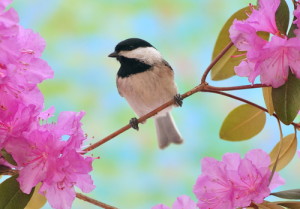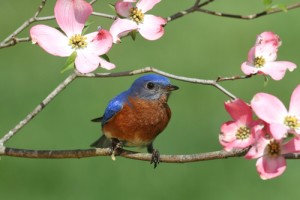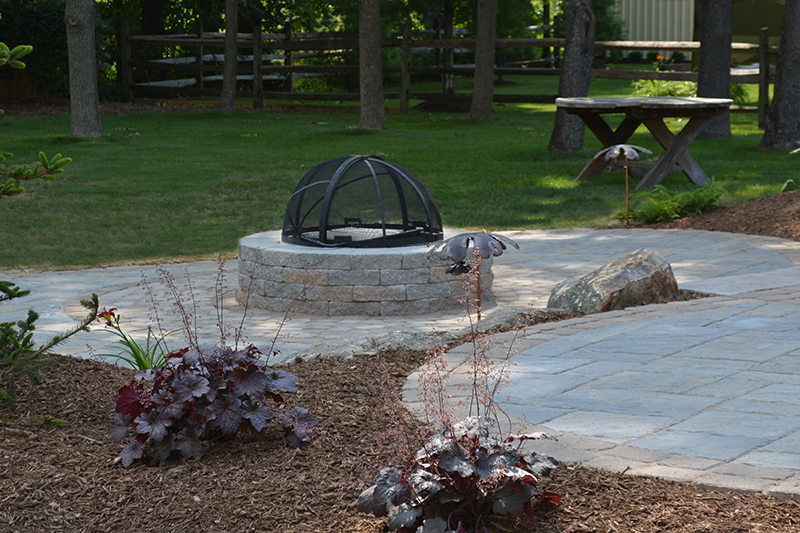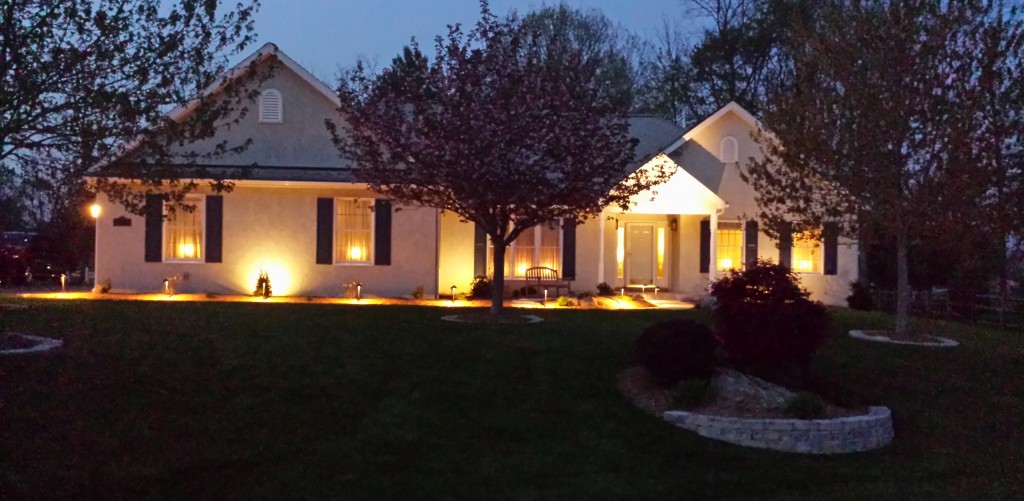SPRING is in the AIR… Let’s TEAM UP to CLEAN UP!
The snow and ice have finally melted, but the winter has left our yards and patios in desperate need of a major spring-cleaning. Now is the perfect time to get some essential spring maintenance done. Then, as temperatures warm up, you’ll be ready to enjoy the outdoors. Typical spring maintenance includes the trimming or pruning of damaged trees and shrubs, clean-up and mulching of landscape beds, removal of debris from turf grass, and prepping outdoor gathering spaces.
Why Trim in Spring?
Trimming shrubbery in spring allows for shaping and controlling of plant growth. It will also allow you to redirect plant growth (i.e. away from a walkway or window). Pruning dead and damaged branches from shrubs and trees will let the plant heal quicker and can prevent the entrance of harmful insects and disease. New buds will form and allow the plant to thicken its growth and keep it from appearing lanky or “wild.” With the investment in plant material and the value that they add to your property, it is best to keep them in good health.
Mulching Makes Sense
Besides making your landscape beds look fresh and aesthetically pleasing, mulching has a lot of other benefits. Mulching your landscape beds annually helps to retain moisture in the ground, block weeds from germinating, protect against soil erosion around the plant and insulate plant roots. As it breaks down, mulch adds organic matter to the soil, which adds beneficial nutrients for plants to uptake through their roots. Spring mulching also provides the opportunity to use a pre-emergent herbicide underneath the mulch that helps to keep the weed seeds in the soil from germinating. Weeds can deprive the plant material from nutrients and moisture in the soil.
Prepping Your Patio
Whether you have a deck or patio, a few simple cleaning chores can turn it from a winter-neglected spot into a fun outdoor gathering space.
- Furniture- If your patio furniture has been out in the weather all winter, it will need to be scrubbed clean. If it has been stored instead, now is the time to brush it off and return it to the patio.
- Grills- If you have a grill, check its connections and operations, following all safety guidelines. Clean the grills and handles, lubricate the lid, and get ready for yummy barbecues.
- Lighting- If your patio area includes exterior lighting, check that bulbs are snugly screwed in and that all fixtures are working appropriately. Remove any rodent, bird, or insect nests and clean the fixtures so they will shine as brightly as possible.
With slowly rising temperatures, longer days, and signs of life reawakening all around us – the onset of spring is a chance to reboot, renew, and start fresh – in all aspects of life. Spring cleaning – just feels good.
Bird-Friendly Landscaping Ideas
Enticing more birds to visit your backyard can be a very worthwhile and enjoyable project for the whole family (our kids love this) and especially for you “birders.” Putting up a feeder is always a quick and easy way to attract birds. However, if you want to attract a wider variety of species, prefer your backyard birds to get a more geographically-natural diet, or wish to create your own backyard bird sanctuary, it’s essential to consider the key landscaping elements that will make your yard more bird-friendly. When planning your landscape, keep in mind that birds need water, food and a place for shelter to survive – especially if you want them to keep coming back. By providing these features, you can create an environment that attracts a variety or very specific types of birds to your backyard. The rewards are beautiful birds that add color and music to your life year-round.
A bird bath is a simple option in providing a water source for the birds. It’s a place for birds to bathe and get drinking water.
While bird houses and bird feeders are an option for shelter and food, also consider adding native plants to your landscape. Native plants provide an excellent source for food and shelter. When designing your landscape, select a variety of plant species from evergreen to deciduous that produce nuts and berries year round. This will provide a natural food source for the birds. Evergreens (trees and shrubs) are also important because they provide shelter during the winter months. Consider your birds’ specific needs and/or incorporate plants that vary in height. Different species of birds will feed, seek shelter and nest at various heights. Planting in groups or clusters forms areas of dense vegetation, creating areas for birds to seek shelter and hide from predators. Perennials can also be incorporated into your design. Perennials not only add a splash of color to your gardens, but they also produce seeds or nectar that attracts birds. A few native perennials to Pennsylvania include Echinacea (Cone Flower), Monarda (Bee Balm) and Lobelia (Cardinal Flower).
Examples of native plants to PA that provide berries: Serviceberry (Amelanchier), Dogwoods (Cornus spp.), Winterberry holly (Ilex verticillata), American Cranberry bush (Viburnum trilobum) & Blueberry (Vaccinium corymbosum).
Examples of native plants to PA that provide cover: American Holly (Ilex opaca), Rhododendron (Rhododendron spp.), Eastern white pine (Pinus strobus), Eastern hemlock (Tsuga canadensis), & Eastern red cedar (Juniperus virginiana).
To attract the most native songbirds, the overall goal of your backyard landscape should be to mimic nature as closely as possible. A properly designed landscape, even if located in an urban area, will attract dozens of species of brightly colored songbirds. In the spring and summer, the joyous songs of these birds are sure to brighten any day.
Mowing Tips!
It’s mowing season! Here are some tips to help keep your lawn looking great!
1) Mow at a height of 2 ½ – 3 inches. This helps promote a deeper root system for the grass plant and reduces weeds in your lawn.
2) Don’t remove more than 1/3 of the blade at a time. This allows you to leave the clippings, which returns valuable nutrients back to the soil.
3) Keep you mower blades sharp! Mowing with a dull blade shreds the ends of grass blades. This leaves behind grass with ragged ends, which turns brown, giving the lawn a dried-out look. It also makes the grass more vulnerable to disease.
4) Try and mow when the grass is dry.
Tired of looking at that boring old concrete in the front of your home? Then, complement your home’s architectural style and add curb appeal with beautiful and durable paving stone walkways, pathways, and garden paths.
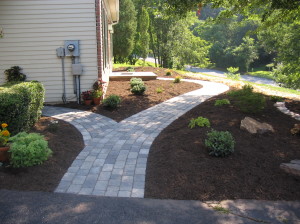
Materials used are Techo-Bloc Allegro style pavers in the Shale Gray color laid in a running bond pattern.
For our new and fresh design ideas, expert tips and first-looks at our latest projects, follow us on Facebook.
Outdoor Living Dreams Become a Reality
Now is the best time of the year to plan for the landscaping needs of your property. Winter is FINALLY gone and spring is here at last! The grass is turning green, the trees are starting to bud and before long, flowers will be in full bloom. Let’s begin surveying your gardens to determine if expansion, renovation, or simply maintaining your existing landscape is the perfect place to start. Maybe instead you’re looking for improvements that will add to your home’s curb appeal and value? Either way, our experts are here to help with the dirty work so you can enjoy lounging on the patio or grilling up some springtime fun.
Hardscape Features
If that “outdoor living” feeling is something you desire, a patio is often seen as the perfect extension of indoor living space. With a backyard paver patio, you can enjoy up to three seasons of the outdoors while you grill, entertain family and friends, or simply relax while observing nature. We’ll also help you plan for form AND function with any necessary walkways or retaining walls. Always consider that when deciding on hardscape features, form follows function, so consider your needs before you implement. You can always count on us for attractive designs that are also built to last and add the best traffic flow to your property.
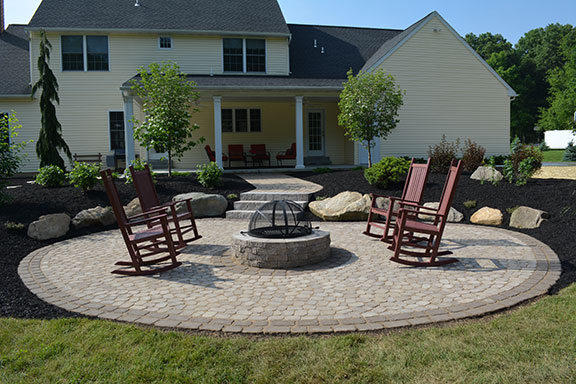 Plant Material
Plant Material
It is important to take time to assess your existing landscaping before making decisions on future enhancements. Here are some basic questions to consider as you begin the process:
- Have all the plants survived the winter?
- Are there voids in the planting beds that should be filled with trees, shrubs or perennials?
- Do you want to renovate your landscape for a fresh look?
When selecting plant material, take into consideration soil type, the amount of sunlight a plant needs, the overall plant size, and the site in which the plant will be placed. Putting the wrong plant in the wrong place can not only be detrimental to that plant’s health, but it can also have a negative effect on the health of the plants growing around it. With proper plant selection, your home can have landscaping beds that are full of color and texture year round.
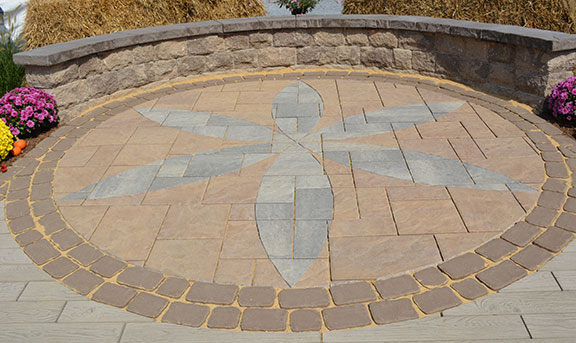 Yearly Maintenance
Yearly Maintenance
It is essential to maintain your landscape throughout the year. Busy lives many times pull our attention away from routine maintenance but tasks like mulching in spring will help keep weeds down, as well as protect plant roots and help maintain moisture. However, if not maintained, weeds can quickly overtake your landscape beds and have a negative effect, both aesthetically and on plant health. Proper pruning of trees and shrubs will keep them healthy by removing dead or damaged branches and allowing for new plant growth. Throughout the year, monitor for various insect pests, such as beetles and aphids, that can easily kill plants if left untreated. Keep lawn areas free of leaves and debris. These few simple steps will keep your landscaping looking fresh, healthy and inviting all year long – just know we’re always here to help when and if you need a helping hand.
Firepits
Fall is right around the corner. The leaves will be changing colors and the evenings will be cooler. Those cool, crisp evenings don’t have to mean the end of outdoor fun and entertainment. Incorporating a fire pit feature into your landscape design is a great way to extend the use of your outdoor living space.
When designing your fire pit there are many things to consider. Fire pits can be constructed out of a variety of material from natural stone to decorative block. They can be designed in a variety of shapes (round, rectangle, or custom). Choose a material and a shape that compliments your home and landscape. Don’t forget seating and traffic flow around the fire pit. Are you going to use outdoor furniture or do you want to incorporate a seating wall? Make sure that there is enough room to move around the fire pit safely.
A fire pit can help to create a focal point in your landscape. It becomes a natural gathering place for family and friends. It provides warmth on cool evenings. Adding an optional grate for cooking will allow you to make everything, from s’mores to kabobs to burgers and steaks. It lets all who gather be involved.
Benefits of Landscape Lighting
Landscape lighting has many benefits. Landscape lighting adds not only beauty to your landscape, but also safety and security. It allows homeowners to display and use their outdoor living space both day and night.
Increase Function
Landscape lighting allows you to extend the use of you outdoor living space. Lighting in seating walls and along patio edges creates a relaxing atmosphere for entertaining guests at night.
Increase Curb Appeal
The use of landscape lighting will make your home feel warm and inviting to your guests. It can be used to highlight specimen plant material, water features, and architectural features of your home.
Increase Security
Landscape lighting can be a deterrent to crime. Landscape lighting can be used to illuminate your home’s exterior, especially entryways, and reveal dark areas where someone can hide.
Increase Safety
Using landscape lights to illuminate driveways, pathways, steps and other dark areas of your yard and landscape will allow you, your family and friends to safely walk around outside at night.
 Houp Landscaping – Enhancing Nature's Beauty
Houp Landscaping – Enhancing Nature's Beauty